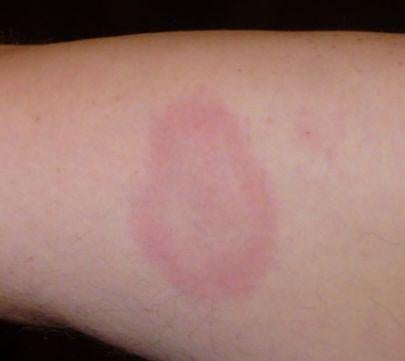

The rash is not usually painful or itchy and will often fade without treatment. On lighter skin tones, the site may be yellow, red, or flesh-colored.

The rash can appear deeper in color on darker skin, with a purplish-red edge around the outside. These bumps grow into a ring and mainly develop on the feet, legs, hands, or arms. In this condition, a raised round rash forms with a distinctive border of small, firm bumps. Although the affected skin looks like ringworm, the center of the rash remains a solid color. Granuloma annulare is a rare, chronic skin disorder that is not contagious or cancerous. Share on Pinterest Granuloma annulare on a medium-dark skin tone. Also, the symptoms worsen in cold, dry climates and in people with poor blood circulation. Dry skin, extreme stress, sensitivity to a particular metal, and medication may all be triggers. It is not clear what causes nummular eczema. Often, patches will flare up in the same spots on the body, and in serious cases, patches can leak fluid or crust over. Itching or burning sensations in these areas worsen at night and can be severe.

The areas will look much darker or lighter on darker skin tones. On lighter skin tones, they appear scaly and pink or red. These spots measure 2–10 cm across, although they may be smaller. In contrast, ringworm spreads out with a clear center encircled by a discolored ring. However, nummular eczema starts as tiny spots that turn into a rash. Ringworm and nummular eczema both look similar because of a circular rash pattern. This type of eczema occurs mainly on hands, arms, or legs and sometimes on the trunk. Nummular eczema, also known as discoid eczema, is a disorder that causes coin-shaped patches of itchy, swollen skin to appear. Share on Pinterest Nummular eczema on a lighter skin tone.


 0 kommentar(er)
0 kommentar(er)
